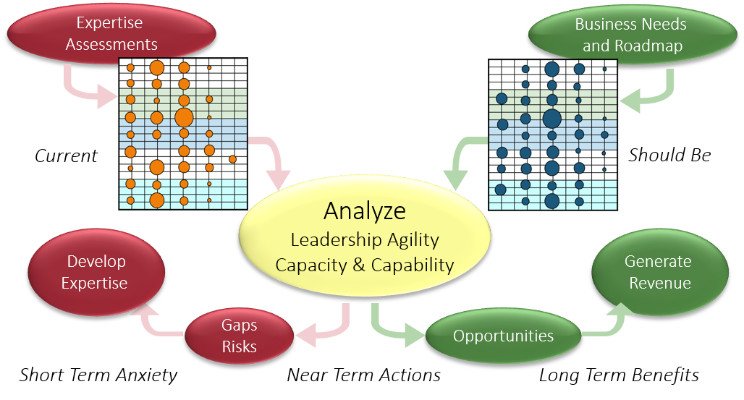Talent Mapping – Your Solution to HR Optimization
During my management years, I was challenged by limited training budget, ever increasing demands for new skills, and HR approach to tracking training. In spite of our sincere efforts to match employee skill level with job description and project requirements, we always had a list of gaps to be filled and training to be scheduled. By the time we catch up, the demand changed.
One day, we asked “How can we approach this with a design mindset” That led to creation of a talent map. If I can visually design the talent needs for my business unit, and compare it what exists in today, then I can figure out the gaps/risks to plan the talent development and also leverage the underused skills to create opportunities.
Talent Map
In its simplest form, a talent map is a matrix of skills and levels. Skills are grouped under Core trade skills, peripheral skills, support skills, operational skills, and leadership skills. A list of about 15-20 is adequate. You can choose skill levels between a total of 3-5, say Trainee, Functional, Independent, Expert, Rare. A map would look like a bubble chart, where the bubble size represents the number of employees at a particular skill level for a specific skill.
The desired or should be state map would be derived from business requirements addressing the type and amount of work. The current state map would be an aggregate of all individual employees. The gap defines the organizational need for training. With some consideration to employee interests, we can develop an optimum training plan for individuals as well groups/teams. If we can look ahead the business requirements, we can develop skills in time.
Application
How to build the current state map
- Agree upon the skill items.
- Supervisor to fill out the matrix for each employee.
- Add up all employees for an organization to get the org map.
How to build the desired state map
- Look at the customer sponsored programs in the organization
- Fill out the requirement matrix for each program under trade, support and operational skills. Use a generic starter distribution across the levels, and adjust to meet the difficulty/risk.
- Add up all programs for an organization
- Add the peripheral skills, and leadership skills based on company growth strategy.
- Review as a leadership team, question assumptions and debate the data to arrive at a consensus.
I have now used this concept at various organizations with some significant tangible benefits. It also helped clarify what portions of the projects can be optimally outsourced, without hurting present delivery quality and without compromising future capacity. With couple of my clients we have extended this application to Knowledge mapping, and Asset mapping.
Value Derived
Primary benefit is to design an optimum training plan so the training investment brings maximum benefit to the business. It also provides an optimum and balanced allocation of talent across projects.
There are lot of additional benefits from this map. Such as Succession planning, compensation parity, critical skills management, leadership development track, building new business development teams, risk assessment, turnover reduction, efficiency improvement, employee engagement, better quality and consistent job descriptions, …
Discovery Question and Improvement Opportunity
Have you ever tried talent mapping? If not, I will be happy to share a template with you.
for more information please visit us at : www.inspiringnext.com

